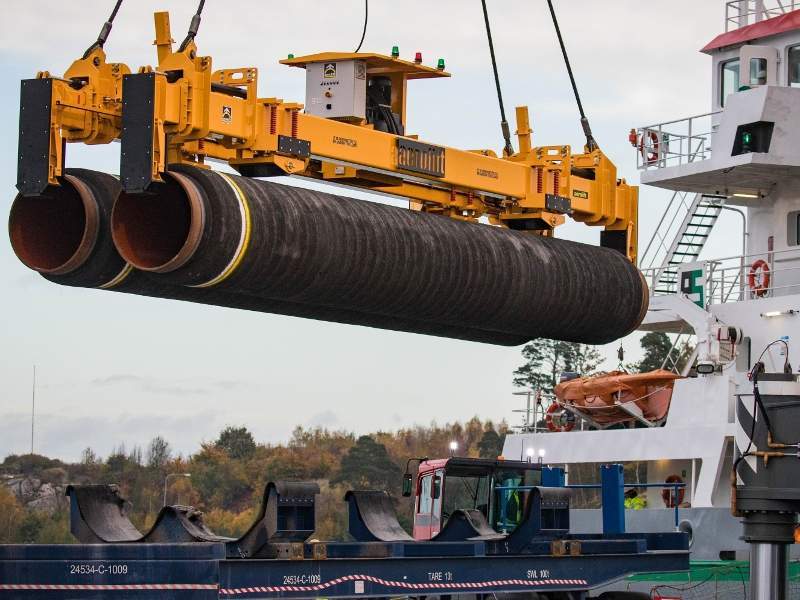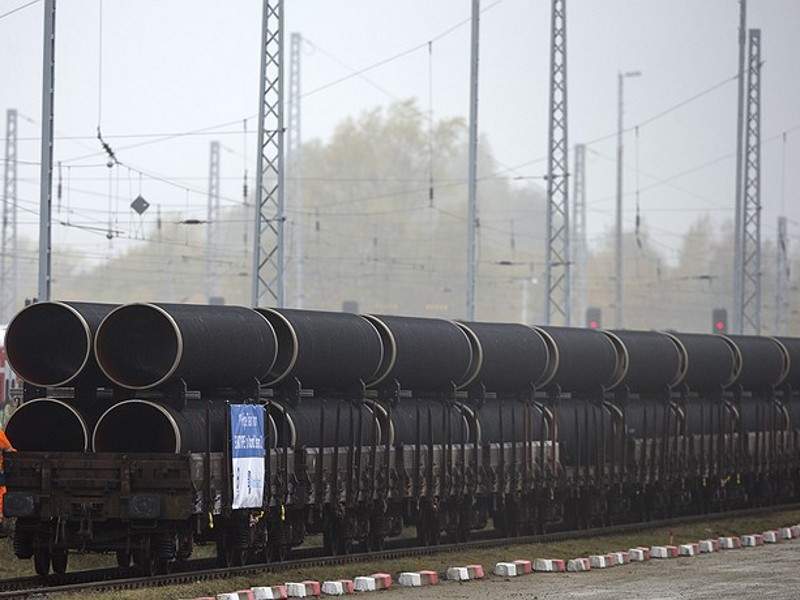Nord Stream 2 is a new gas export pipeline built to deliver Russian gas to Europe, across the Baltic Sea. Russia’s state-owned gas export monopoly Gazprom built the twin 1,230km pipeline through its wholly-owned subsidiary Nord Stream 2 based in Switzerland, which will also own and operate the pipeline.
Nord Stream 2 follows the design and route of the existing Nord Stream pipeline, which had delivered 400 billion cubic metres (bcm) of Russian gas to Europe as of April 2021, since it entered service in November 2011.
Originating from eastern Russia, the new pipeline passes through Finnish, Swedish, and Danish waters to terminate near the German coast of the Baltic Sea. The construction of the pipeline was completed in September 2021 with gas flows expected to start in 2022.
However, the future of the pipeline has become uncertain with Germany suspending the certification of the pipeline due to Russia’s invasion of Ukraine in February 2022. Nord Stream 2 also requires certification by the European Union (EU), before it could begin operations.
If operational, Nord Stream 2 will carry up to 55bcm of gas doubling the annual gas export capacity of the Nord Stream system to 110bcm. It will serve approximately 26 million households in Western Europe.
Nord Stream 2 gas pipeline development
The feasibility study for the Nord Stream 2 pipeline project was started in 2011 and completed in 2013. Construction approvals in Germany, Finland, Sweden and Russia were received respectively in March, April, June, and August 2018, while those for the Danish segment were obtained in October 2019.
Preparatory works for the pipeline started in 2016 and the first set of pipes that Europipe manufactured for the project arrived at the Mukran logistics hub in Germany in October 2016.
Offshore construction works started in the Gulf of Finland, with the use of a 300m-long pipe-laying vessel named Solitaire in September 2018.
Construction delay due to the US government’s sanctions
The Nord Stream 2 pipeline was originally expected to enter service by the end of 2019 or in early 2020. However, the USA’s Trump administration signed a law to impose sanctions on the companies engaged in the Nord Stream 2 pipeline project in December 2019.
By then, the overall construction of the cross-border pipeline was completed by almost 94%, with pipe laying on a 160-km stretch in Danish waters and works on pipeline endpoints in Russia and Germany pending completion.
Fearing the US sanctions might block its access to the US financial system, Swiss-Dutch deep-sea pipe laying company Allseas suspended work on the project in the same month.
Construction was restarted using Russia’s own pipe-laying vessel Fortuna in January 2021 despite the US imposing sanctions on the vessel as well as its owner KVT-RUS in the same month.
The Biden administration waived the US sanctions on Nord Stream 2, the company executing the pipeline project, in May 2021, but imposed fresh sanctions on Ostap Sheremeta, a new build Russian offshore supply ship, Nobility, the owner of another vessel engaged in the Nord Stream 2 project, as well as the construction firm Konstanta in August 2021.
Nord Stream 2 pipeline design details
The Nord Stream 2 pipeline runs parallel to the existing Nord Stream pipeline. It consists of two strings with a capacity of 27.5bcm each.
Each string consists of 100,000 coated steel pipes, while each pipe joint measures 12m-long and weighs 24t. The internal diameter and wall thickness of each string are 1.15m and 41mm, respectively.
Nord Stream 2 gas source and supply details
The pipeline will transport gas produced by the Bovanenkovo natural gas field located in Yamal Peninsula, Russia. The gas field is estimated to contain 4.9 trillion cubic meters (tcm) of recoverable gas.
The feed gas will be received via Gazprom’s Slavyanskaya gas compressor station located near Narva Bay.
The natural gas delivered by the pipeline will be first received at GASCADE Gastransport’s Lubmin 2 natural gas receiving station near the Bay of Greifswald in northern Germany. The Lubmin 2 station will further connect the Nord Stream 2 pipeline to European Gas Pipeline Link (EUGAL) and Northern European gas pipeline (NEL).
Pipeline route
Nord Stream 2 originates at the Slavyanskaya gas compressor station near Narva Bay and runs 3.2km onshore along the sea coast before stretching for 114km in Russian offshore waters to connect to the Finnish section of the pipeline.
It further runs 374km offshore in Finnish waters and 510km in Swedish waters in the Baltic Sea before entering Danish waters, with the section in Denmark being 139km long.
The German section of Nord Stream 2 comprises 85km of offshore and 29km of onshore segments connecting the Lubmin 2 gas receiving station.
Financing for the Nord Stream 2 project
The total investment on the Nord Stream 2 pipeline project is estimated to be £8.4bn ($11bn).
Gazprom, the sole shareholder of the project invested more than half of the project cost, while the remaining was invested by Engie, OMV, Royal Dutch Shell, Uniper, and Wintershall.
Engie, OMV, Shell, Uniper, and Wintershall agreed to invest $1bn each on the pipeline project, as part of a financial agreement signed with Nord Stream 2, in April 2017.
Contractors involved
German company Europipe and Russian companies United Metallurgical Company (OMK) and Chelyabinsk Pipe-Rolling Plant (Chelpipe) were selected as the pipe suppliers for the Nord Stream 2 project in March 2016.
Europipe was to supply 40% of the total pipe joints required for the project, while OMK and Chelpipe were responsible for the remaining 60%.
Wasco Coatings Europe was awarded the concrete weight coating, pipe storage, and logistics contract for the project, in September 2016.
Blue Water Shipping was awarded a $46m subcontract by Wasco Coatings for the transportation, handling, and storage of pipeline segments in Germany, Finland, and Sweden, in June 2017.
A joint venture of Boskalis and Van Oord was awarded a $291m rock placement contract as part of the preparatory work for the project, in July 2017. Allseas was contracted to supply its offshore pipe-laying vessel Solitaire, in April 2017.
Kvaerner was awarded a contract worth $73m for the civil, mechanical, and piping works related to the onshore facilities at the export landfall of the pipeline in Russia, in 2017.
Saipem was awarded the pipe-laying contract for the offshore segment of the pipeline in Germany by using its pipe-laying vessel named C10 in August 2017.
Nord Stream 2 project controversy
Being entirely controlled by Russia, the Nord Stream 2 project generated more geopolitical tensions than the pre-existing Nord Stream pipeline.
The US, along with most of the Central and Eastern European countries such as Ukraine, Poland, Romania, Slovakia, Hungary, Latvia, and Lithuania, disapproved of the project apprehending that the pipeline would increase Europe’s energy dependence on Russia leading to the growing influence of Russia in the region.
The pipeline is alleged to not only undermine Europe’s energy security but also deprive Ukraine of transit fees earned from the existing pipeline infrastructure for the Russian gas supply to Europe.
The governments of Ukraine, Lithuania, Bulgaria, Czech Republic, Estonia, Greece, Poland, Romania, and Slovakia gave a representation to the European Commission voicing their disapproval of the Nord Stream 2 project, in December 2015.
Furthermore, Ukraine filed a lawsuit with the Energy Community Secretariat of the European Union requesting an order to stop the construction of the project, in February 2016.
The European countries were divided on their opinion on the project, with Germany, which imports more than half of its natural gas from Russia, being at the centre of criticism by the opponents.
Germany had been supporting the pipeline as an important commercial project, until it had to halt the process of issuing operating licence for the pipeline in February 2022 amid growing international pressure due to the Russia-Ukraine crisis.
The US also imposed tougher sanctions on Nord Stream 2, the Swiss-based company which built the pipeline, due to Russia’s military operation in Ukraine.
The company reportedly laid off its employees and filed for bankruptcy in March 2022.







